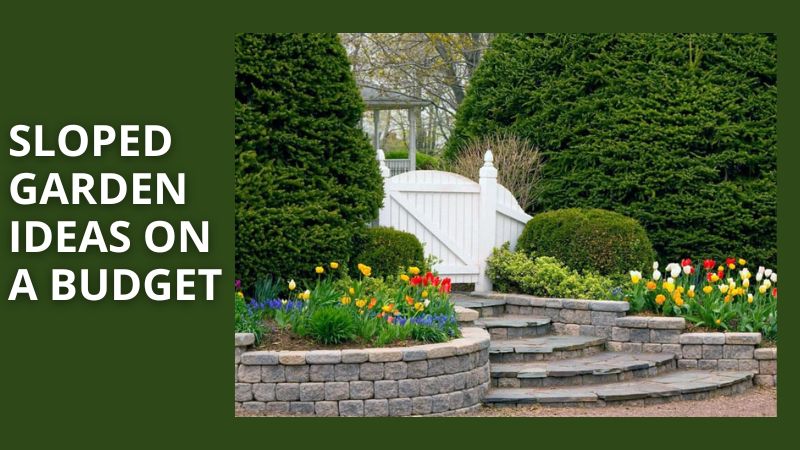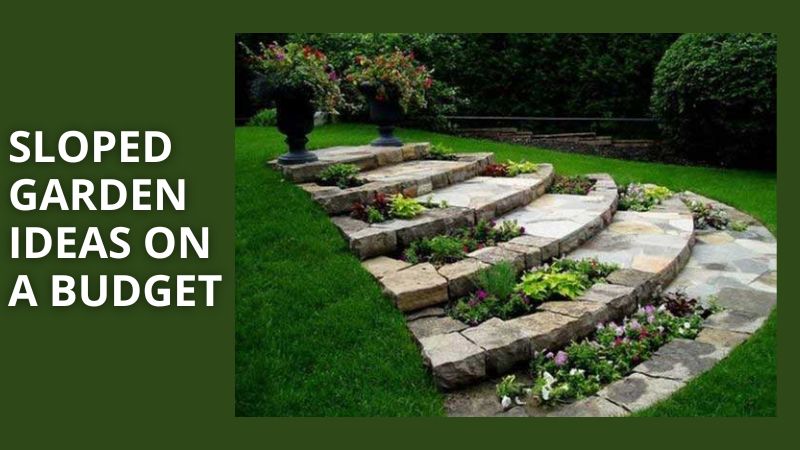OTHER IDEAS
10 Creative Sloped Garden Ideas on a Budget
Transforming a sloped garden can be a rewarding project, especially when working with a tight budget. The challenge of a sloped landscape offers a unique opportunity to implement innovative design ideas that enhance both functionality and beauty. Below Floral Garden Ideas will share with you ten sloped garden ideas on a budget to help you turn your sloped garden into an attractive and dynamic outdoor space.
10 Creative Sloped Garden Ideas on a Budget
DIY Terraced Garden
Terracing can be a highly effective way to manage a sloped garden and create usable planting areas. By breaking the slope into a series of level sections, you not only improve drainage but also add visual interest.
How to Do It:
- Materials: Use reclaimed bricks, wooden pallets, or inexpensive retaining wall blocks.
- Steps: Dig into the slope to create flat sections. Install your chosen retaining materials to build up each level, then fill with soil or compost.
- Cost-saving Tip: Look for free or cheap reclaimed bricks or wood at local salvage yards or online marketplaces.
Stepped Pathways
Creating a stepped pathway can help in navigating the slope while adding a stylish feature to your garden. It’s a functional and aesthetic solution that can be achieved with minimal expenditure.
How to Do It:
- Materials: Use concrete pavers, stepping stones, or even large flat stones.
- Steps: Plan your pathway layout, mark it, and dig out the path. Place your stepping stones or pavers and fill gaps with gravel or mulch.
- Cost-saving Tip: Source stepping stones from garden centers during sales or check for second-hand options online.
Rain Garden
A rain garden is a sustainable option that manages runoff from your slope, reduces erosion, and supports local wildlife. It’s a practical and eco-friendly addition to any sloped garden.
How to Do It:
- Materials: Native plants, mulch, and garden soil.
- Steps: Choose a low-lying area to collect water, dig out a shallow depression, and fill it with a mix of native plants that thrive in wet conditions.
- Cost-saving Tip: Opt for native plants that are often less expensive and more resilient to local conditions.
Raised Garden Beds
Raised garden beds are excellent for sloped gardens as they improve soil quality, enhance drainage, and create distinct planting areas. They can be made from various budget-friendly materials.
How to Do It:
- Materials: Reclaimed wood, old pallets, or concrete blocks.
- Steps: Construct the bed frame, secure it in place, and fill it with a mix of soil and compost.
- Cost-saving Tip: Repurpose old wood or pallets to reduce costs and add character to your garden.
Hanging Planters
Utilizing vertical space with hanging planters is a creative way to incorporate greenery into a sloped garden. It’s ideal for small spaces and adds an interesting visual element.
How to Do It:
- Materials: Recycled containers or inexpensive hanging baskets.
- Steps: Install hooks or brackets on a sturdy structure like a fence or wall. Hang your planters and fill them with soil and plants.
- Cost-saving Tip: Reuse containers you already have or find affordable ones at thrift stores or garden centers.
Rock Gardens
Rock gardens are a low-maintenance solution that can add texture and visual appeal to a sloped garden. They are perfect for dry, well-drained areas and can be constructed with minimal expense.
How to Do It:
- Materials: Rocks, gravel, and hardy, drought-tolerant plants.
- Steps: Arrange rocks in a naturalistic way to create beds or borders. Fill gaps with gravel and plant drought-resistant species.
- Cost-saving Tip: Gather rocks from your property or local sources for free, or purchase them in bulk.
DIY Wooden Steps
If you prefer a more rustic approach, wooden steps can be a cost-effective way to navigate your sloped garden. They provide both functionality and a charming aesthetic.
How to Do It:
- Materials: Old timber or recycled wood.
- Steps: Cut the wood into step-sized pieces and secure them into the slope, ensuring they are level and sturdy.
- Cost-saving Tip: Reuse wood from old pallets or construction sites to save money.
Slope-Stabilizing Plants
Incorporating ground cover plants can help stabilize the slope and prevent erosion. They also add greenery and color to your garden without requiring significant investment.
How to Do It:
- Materials: Fast-growing, erosion-control plants like clover, creeping thyme, or sedum.
- Steps: Plant ground covers in dense patches across the slope to create a natural barrier against erosion.
- Cost-saving Tip: Purchase young plants in bulk or propagate from friends or local gardening groups.
Budget-Friendly Outdoor Seating
Creating a seating area on a slope can transform it into a relaxing retreat. You can build a simple bench or use affordable outdoor furniture.

How to Do It:
- Materials: Reclaimed wood, concrete blocks, or budget outdoor furniture.
- Steps: Build or arrange your seating in a flat or gently sloped area, ensuring it’s stable and comfortable.
- Cost-saving Tip: Look for second-hand furniture or use reclaimed materials to keep costs low.
DIY Garden Edging
Adding garden edging along the slope can help define different areas and prevent soil erosion. It’s an easy and cost-effective way to enhance the appearance of your garden.
How to Do It:
- Materials: Recycled bricks, logs, or inexpensive plastic or metal edging.
- Steps: Install the edging along garden beds or pathways to create clean lines and prevent soil runoff.
- Cost-saving Tip: Use materials you already have or find budget-friendly options at garden centers.
Conclusion
A sloped garden presents unique challenges, but with these creative and budget-friendly ideas, you can make the most of your outdoor space. From terraced gardens and stepped pathways to rain gardens and rock gardens, each solution offers a way to enhance both the functionality and beauty of your garden. By incorporating reclaimed materials, repurposing what you already have, and choosing low-cost options, you can achieve a stunning transformation without exceeding your budget.


